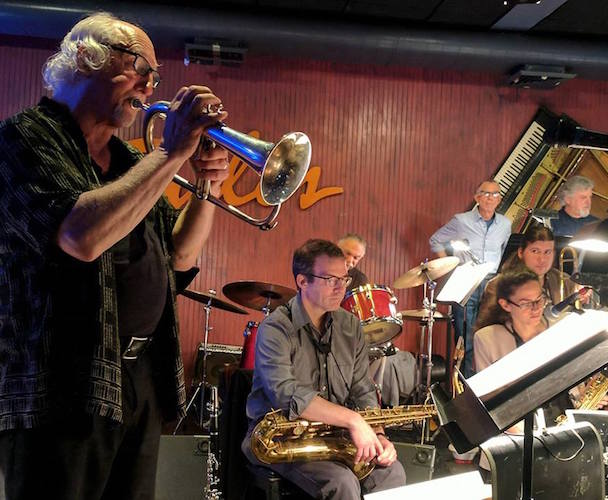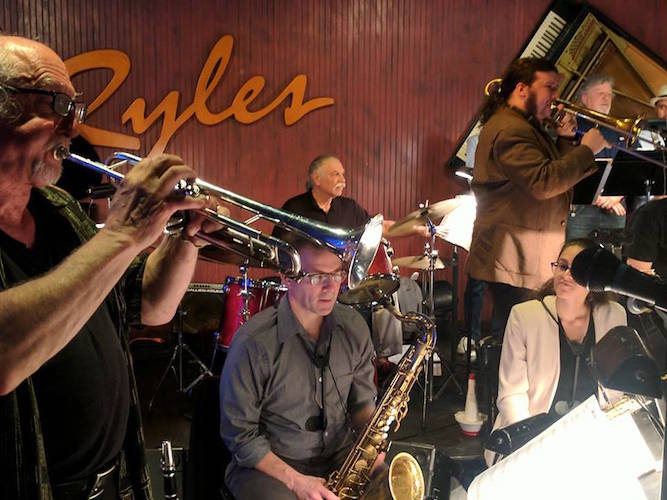Jazz Commentary: Greg Hopkins Big Band at Ryles — Whither Big Bands?
At this time in the Boston jazz scene, there are no ongoing spaces for big bands and, predictably, the number of such ensembles has shrunk.

Photo: Greg Hopkins and his big band at Ryles Jazz Club. Photo: Rob Chalfen.
By Steve Provizer
On June 7th, it was nice to sit back at the Ryles Jazz Club and bask in the sounds of a swinging 19-piece big band. But there was also a feeling, hard to shake, that there were tectonic movements afoot below the surface, that I was witnessing a shift in the DNA of Boston jazz. Still, on the bandstand, a mighty roar was heard, so, let’s talk first about the music.
Ryles was packed: on the stage, the dance floor, and in the seats. A serious buzz in the air was present from the beginning, when the band kicked the show off with a hard swinging blues. The troupe’s arrangements all came from the pen of leader/writer/trumpeter Greg Hopkins, a mainstay on the scene since the ’70s. Most of the tunes were originals, with a few standards. Hopkins’ compositions included “This One’s For Brownie,” a tribute to Clifford Brown, “The Soothsayer,” written when Obama was elected, “Nightfall,” and “Okabongo, Jewel of the Kalahari.” Standards included “In a Sentimental Mood,” “Spring is Here,” and “Body and Soul.”
The centerpiece of the night was Hopkins’ composition “The Dream Catcher,” penned in honor of the closing of Ryles (on June 30). Written in five parts, it’s an ambitious work that gave me a feeling of moving between clearness and blurriness. Taken as a whole, Hopkins’ arrangements use pretty much every compositional device you can think of; this tune was a concentrated dose of this approach. Reed players double on a range of horns to expand the tonal scale, including moving to bass and alto clarinets, four clarinets and multiple flutes. Individuals, duet pairings, and sections solo, sometimes with chord changes, sometimes free, against varied backgrounds. There are shifting meters, interplay between sections and ostinati. The band had one rehearsal to pull it all together — and under Hopkins’ experienced leadership, it did.
Hopkins is as active a leader as I’ve even seen. Throughout the night, he picks up and puts down his trumpet and fluegelhorn for solos and joins the trumpets in sectional playing. Sometimes he wanders through the orchestra, demonstrating to a section background riffs that he wants them to play. He conducts effectively, occasionally with a near ferocious energy, the same way he plays the cowbell or beats time with his baton on a music stand. He’s a guy who clearly loves his work.
The band is made up of skilled pros who can play the most complex lines in synch and in tune. All the soloists were convincing: I would single out for especially fine work tenor player Rick DiMuzio, trombonists Jeff Galindo and Max Acree, and guitarist Tim Miller.
This ode to the music brings us to the “tectonic shift” I mentioned earlier. First and most obviously, the concert was at Ryles. Which, as noted in a previous article, is closing at the end of June. As Hopkins noted, he had played at Ryles in various sized groups hundreds of times since the mid-’70’s. The bittersweet vibes were palpable.

Ilona Kudina, flute, John Lockwood, bass, Tim Miller, guitar, and Doug Johnson, piano at Ryles. Photo: Rob Chalfen.
At this time in the Boston jazz scene, there are no ongoing spaces for big bands and, predictably, the number of such ensembles has shrunk. An event like this one is rare. and what payment the band members pick up is probably just enough to cover the bar tab. I only know some of the musicians in the Hopkins band, but it’s fair to say that the chief income source for most of these players is teaching. Early on in a career this might mean going to houses to teach, then setting up a studio in the musician’s home, eventually working at a local music store or adult ed program, or working part or full time in a music school. Hopkins has been teaching at Berklee College of Music since 1974.
The future for jazz looks challenging, particularly as it is overtaken by (or absorbed) into hip hop, R&B or pop. Playing-gigs as well as teaching-gigs may become harder to come by. On the other hand, Berklee College of Music seems to be an agile institution, constantly making adjustments in its outreach, going outside the US to draw students, and updating its curriculum to include teaching digital technology and recording in order to reach young people who may have little knowledge of or interest in jazz.
Then, there was the fact that there was a packed house at Ryles. Good — yes, but this kind of excitement about hearing a home-grown group has become rare. Notably, the sets were at 9 and 11 p.m.. This was once the norm but, in recent years, the shows have been starting earlier and earlier — often at 7:30, and there may only be one set. These changes are doubtless a response to the aging of the jazz audience. And indeed, at this concert, the majority of the crowd left after the first set.
Then, there’s the question of the demographics of the performers. First of all, in an issue noted in a recent Arts Fuse commentary by Clea Simon about the Jazz at Lincoln Center Orchestra, there was a noticeable lack of women in the Hopkins big band. Of the nineteen, there were only two. Also, there were few musicians of color. Only one player seemed to be non-caucasian. Let me be clear, I absolutely don’t mean to imply any racist intent on anyone’s part. What I’m saying is that, in Boston, jazz big bands are like bubbles in time. Is there not a responsibility among artists to reflect the social/political/racial currents of the time?

Photo: Greg Hopkins and his big band at Ryles. Photo: Rob Chalfen.
Yes, this is a rather downbeat analysis. But I’ve become used to going to so many badly attended jazz concerts that, ironically, the heightened atmosphere of this concert at Ryles ended up clouding my normally rose-colored glasses. My eyes were sicklied o’er with the pale cast of thought. My repressed “if-only’s” rose to the surface.
Part of the job of the jazz community is to make sure listeners of all backgrounds know about concerts, to make the music appealing to as broad an audience as possible. This raises issues of self-reflection: leaders and organizers should understand that gender and racial inclusion matters. Turning away from that responsibility only strengthens the walls that are already separating the music from potential audiences. And jazz needs more packed rooms.
Big Band Personnel: Scott deOgburn, trumpet; Jeff Galindo, trombone; Ilona Kudina, flute; Christian Marrero, trumpet; Max Acree, trombone; Allan Chase, alto saxophone; Don Gorder, trumpet; Jeff Hoyer, trombone; Lihi Haruvi, alto saxophone; Dan Rosenthal, trumpet; Peter Cirelli, bass trombone; Rick DiMuzio, tenor saxophone; Greg Hopkins, leader, trumpet; Bob Patton, tenor saxophone; Ben Whiting, baritone saxophone, bass clarinet; Doug Johnson, piano; John Lockwood, bass; Bob Tamagni, drums, Tim Miller, guitar.
Steve Provizer is a jazz brass player and vocalist, leads a band called Skylight and plays with the Leap of Faith Orchestra. He has a radio show Thursdays at 5 p.m. on WZBC, 90.3 FM and has been blogging about jazz since 2010.


Thanks for the kind words, but I disagree. It IS NOT the duty of every jazz musician to highlight whatever underlying social or political issues that may or may not exist in the world. Jazz is about the experience and freedom of the individual to express themselves in whatever way they want; however political, social or otherwise that may be. Greg is a very esoteric and spiritual man. His music is composed in a way that is supposed to reflect a different plane of existence than the mundane one we occupy.
For one, I find it a breath of fresh air that Greg DOES NOT try to insert socio-political themes into his music, frankly that spiel has been oversaturated and quite frankly music always has a greater appeal to me when the meaning is more abstract. This is not even to mention that music can quite honestly mean anything to anyone regardless of the composers intent, especially instrumental music. Nothing is set in stone in that way, when a composition is released to the world, it also becomes the worlds in the way they perceive it. In terms of your weird preoccupation with having a more racially or gender diverse group, I can say this. This group of musicians is made up of BY FAR the best jazz musicians in the city of Boston. They are the best people for the job regardless of gender or race.
I’ve heard a hell of a lot of players in my day and I can say this for sure; Greatness follows no quota. Those who are willing to dedicate their life to the craft, do the most listening, do the most productive practice sessions + have a whole hell of a lot of luck, good ears, patience etc… are the ones who make it. In today’s climate it just seems as though people don’t always understand that they are simply not as good or not as suited for a job as they think they are. The cards fall where they fall, and if you can’t hack it you can’t hack it. You also got another thing wrong, I’m of mongolian-siberian decent on my mother side and as such do not consider myself white. Add it to the list. Thanks.
Max,
Thanks for your reply. I agree that the meaning of music is in the ear of the beholder. And, I agree that these musicians, as I hope I made clear in the article, are all top notch. But I maintain that there is a reason to consider the racial and gender mix of the group.
You may disagree, but I think that there is still a lot of separation between different racial groups of musicians in Boston. It stands to reason that we know the people in our own circle and often the boundaries of those circles are drawn along racial lines. Not always, of course, but often. This is the heritage of a city that has a history of segregating musical communities. No one needs to be “blamed” for this and the way out is not easy, but one way to approach it is for influential band leaders to be aware of it and make personal efforts to locate worthy musicians they would not normally find in their own musical orbit.
Steve Provizer